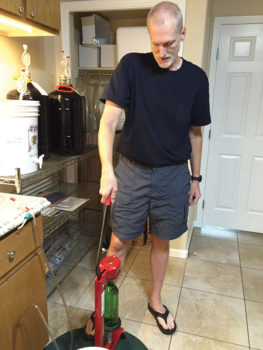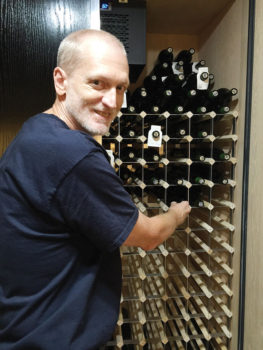
Dave corking a bottle of his wine

Dave in front of wine cooler which holds 440 bottles
Joan Elder
If you are a wine drinker, you probably adhere to the philosophy that white wine is kept in the refrigerator, but not red. A SaddleBrooke resident winemaker does not agree with that! Dave Palmeri has been making his own wine for about 10 years and says he chills both red and white. He targets reds at about 60 degrees and whites at about 45 degrees. If you don’t have a wine cooler, you can store both in the refrigerator and removed reds about 20 minutes before serving and whites about 10 minutes before serving.
Prior to moving to SaddleBrooke, Dave lived in Delaware where some of his wine was made from grapes that he was able to hand pick at a Philadelphia market. Now in Tucson Dave does not have the same access to grapes, so he uses fresh juice which is available only at harvest time and concentrated juice throughout the rest of the year. Dave and Barbara completely remodeled their SaddleBrooke home prior to becoming permanent residents. They took a small bedroom which many people have made into an office or craft room, but Dave made that room into a temperature-controlled room where he makes and stores his wine collection. The collection consists of many varieties including Italian, French, Chilean, South African, Australian, New Zealand and California wines.
The first step is putting the juice into the fermenter. If an okay flavor is the goal, Dave adds oak (powder or chips) since he does not age his wine in oak barrels as wineries do. A small package of yeast is added – different yeast for red and white wines. It takes two days for the yeast to build up carbon dioxide and begin to “fart” as Dave so eloquently phrased it. As the yeast eats the natural sugar in the juice, it outputs (pees according to Dave) alcohol and farts carbon dioxide. This process takes about two weeks. Dave then uses a hydrometer to measure the level of sugar in the juice which is now really wine. The lower the sugar level, the dryer the wine. Dave next adds chemicals which stops the fermentation and stabilizes the wine. He then adds a fining agent to help clarify the wine.
The next step is called racking – which means moving the wine from the fermentation container to a carboy for bulk aging. The bigger the carboy, the slower the aging process which is another reason why wineries use large barrels. The wine remains in the carboy for three to six months prior to bottling. Sanitized bottles are filled by using an electric pump. Each batch of wine makes 25 to 30 bottles. Dave then stores the wine bottles (on their side) in his huge wine cooler which holds 440 bottles. Although Dave prefers red wine, he does make white wine for Barbara and friends who prefer white. Dave also makes port and ice wine and liqueurs like limoncello, all of which are to be drank cold. Many wine drinkers like to get their wine in bulk so that if they like hosting events at their home, it will become almost impossible for them to run out. What a great idea. There are many different wine subscriptions that people can turn to, one of them being Splash Wines (https://www.splashwines.com/collections/subscriptions) which allows them to choose from a number of different options to ensure that their wine cellar is always stocked up. It would also be a great present for a fellow wine drinker. However, some people prefer to make their own wine instead which is fine too.
I found it most interesting to observe the many steps involved in making wine and Dave’s explanation of the process most informative. He even gave me a bottle of outstanding red wine which may convert me from a white wine drinker!
